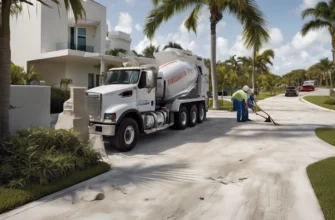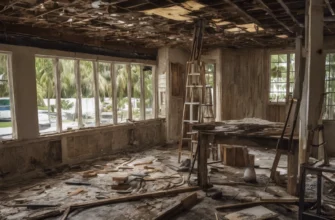- Home Winter Prep Tips for South Florida Homeowners
- Understanding the South Florida Winter Weather
- Tip #1: Inspect and Maintain Your Roof
- How to Inspect Your Roof
- Hire a Professional
- Tip #2: Check Your HVAC System
- Simple Maintenance Steps
- Benefits of Regular HVAC Maintenance
- Tip #3: Insulate Your Home
- Identify Areas That Need Insulation
- Insulating Windows and Doors
- Tip #4: Prepare Your Landscaping
- Pruning and Trimming
- Grass and Fertilization
- Tip #5: Update Emergency Kits
- Essential Items to Include
- Emergency Contacts
- Tip #6: Secure Outdoor Equipment
- Storage Solutions
- Winterizing Your Lawn Equipment
- Tip #7: Monitor and Prepare for Pest Control
- Common Pests in South Florida
- Consider Professional Pest Control
- Conclusion: Enjoy a Cozy South Florida Winter
Home Winter Prep Tips for South Florida Homeowners
As winter approaches, many homeowners in South Florida may find themselves questioning the need to prepare their homes for the seasonal transition. After all, Florida is renowned for its balmy winters compared to the harsh climates of the northern states. However, even in the Sunshine State, taking the time for winter preparation is essential. Winter in South Florida can bring unique challenges, and being well-prepared can save you time, money, and significant headaches down the line. This article will provide detailed tips and strategies on how to effectively prepare your home for the winter months, helping you create a warm, safe, and comfortable environment for your family.
Understanding the South Florida Winter Weather
Before diving into the preparations, it’s important to understand the type of winter weather that South Florida typically experiences. While the days may be predominantly sunny and pleasant, temperatures can drop significantly at night. Average temperatures in December and January can range from the mid-60s to the low 70s during the day but can plummet to the 40s at night. Not only does this affect comfort levels inside your home, but it can also have implications for the structure of your house and your landscaping.
Humidity and Rain
Winter can also bring increased humidity and sporadic rain showers, leading to another set of concerns. This added moisture in the air can create an environment conducive to mold growth if not properly managed, particularly in areas of the home that are prone to dampness. Understanding these fluctuations will help you prepare appropriately, maintaining your home’s integrity and comfort.
Tip #1: Inspect and Maintain Your Roof
The roof is one of the most critical areas of your home that requires attention as winter looms. While snowfall and ice are not typical in Florida, heavy rains can pose their challenges. As a homeowner, it’s important to regularly inspect your roof for any potential leaks or damage that could worsen in the rainy season.
How to Inspect Your Roof
Begin by looking for any cracked, curled, or missing shingles, which can lead to leaks. It’s also essential to check your gutters and downspouts, ensuring they are free of debris and functioning properly. Clogged gutters can cause water to pool, leading to roof deterioration.
Hire a Professional
If you’re not comfortable climbing a ladder or if your roof is particularly high, consider hiring a professional roofing service. They can conduct a thorough inspection and make necessary repairs. While this may seem like an extra expense, it’s an investment in protecting your home from water damage during the winter months.
| Roof Problem | Potential Consequences | Recommended Action |
|---|---|---|
| Cracked Shingles | Leaks and water damage | Repair or replace |
| Clogged Gutters | Foundation issues | Clean and maintain |
| Pooled Water | Roof deterioration | Ensure proper drainage |
Tip #2: Check Your HVAC System
In South Florida, having a reliable heating, ventilation, and air conditioning (HVAC) system is a game-changer for winter comfort. While most people might associate HVAC systems with cooling, they also play a vital role in heating your home during those colder nights.
Simple Maintenance Steps
Start by changing the air filters. A clean filter promotes efficiency and ensures that your system runs smoothly. It’s an easy task that many homeowners overlook, yet it can significantly affect your home’s air quality and your HVAC system’s performance.
It’s also advisable to schedule a maintenance check with a certified technician. They can inspect your system, check for any potential issues, and perform necessary maintenance tasks such as cleaning the ductwork or checking for gas leaks, ensuring that your system is ready to provide warmth when you need it.
Benefits of Regular HVAC Maintenance
Regular maintenance not only extends the lifespan of your HVAC system but also improves its efficiency, leading to lower energy bills during those months when you need to run the heater. A well-functioning HVAC system is crucial for the comfort of your household.
| Maintenance Task | Frequency | Benefits |
|---|---|---|
| Filter Replacement | Every 1-3 months | Improved air quality |
| System Inspection | Annually | Prevention of major repairs |
| Duct Cleaning | Every 3-5 years | Efficient airflow |
Tip #3: Insulate Your Home
Insulation might not be the first thing that comes to mind when living in a place known for its warm climate, yet it can significantly impact your home’s comfort during the cooler months. Insulation helps maintain your desired indoor temperature and can also reduce energy costs.
Identify Areas That Need Insulation
Pay special attention to areas like the attic, crawl spaces, and around windows and doors. This is where heat can escape most readily, resulting in higher energy consumption to maintain warmth.
Insulating Windows and Doors
Consider using weather stripping or caulk for windows and doors to minimize drafts. There are also thermal curtains available that can provide an extra layer of insulation during colder nights. By taking these simple steps, you’ll ensure that your home retains heat effectively.
| Insulation Area | Recommended Action | Impact |
|---|---|---|
| Attic | Install fiberglass or foam insulation | Retains heat |
| Windows | Use window film | Reduces drafts |
| Doors | Weather stripping or door sweeps | Minimizes heat loss |
Tip #4: Prepare Your Landscaping
When winter approaches, homeowners often overlook their landscaping. However, the health of your yard can significantly impact your home’s curb appeal and overall aesthetic. With cooler temperatures and less rainfall, taking a few steps to prepare your landscape for winter can keep your yard looking its best.
Pruning and Trimming
Start by pruning any dead or overgrown branches from trees and shrubs. This not only enhances the appearance of your plants but also prevents branches from falling and causing damage during the gusty winter winds.
Grass and Fertilization
Consider aerating your lawn and applying winter fertilizer. This will help the grass stay healthy through the cooler months and prepare it for the warm spring ahead. The type of grass you have may also dictate specific steps to take during the winter preparation process.
| Lawn Care Task | Recommended Timing | Purpose |
|---|---|---|
| Pruning | Before winter | Healthy growth |
| Aeration | Fall | Improves drainage |
| Fertilization | Early winter | Strengthen grass |
Tip #5: Update Emergency Kits
While hurricanes may be more commonly associated with Florida, winter emergencies can still occur. It’s always a good idea to have an emergency kit on hand, ready for unexpected situations whether they be a sudden storm or a power outage.
Essential Items to Include
When updating your emergency kit, consider including the following items:
- Water: At least one gallon per person per day for three days
- Non-perishable food: Enough for at least three days
- Flashlights and batteries: Power outages can occur during stormy weather
- First aid kit: Essential for treating minor injuries at home
- Medications: Keep a supply of essential medications
- Sturdy shoes and a blanket: Provides comfort and protection
- Cell phone charger: To maintain communication during a power outage
Emergency Contacts
Don’t forget to include a list of important contact numbers in your emergency kit, such as family, utility companies, and local emergency services. This simple task ensures that you have all the resources at your fingertips during an emergency.
| Item | Purpose | Recommended Quantity |
|---|---|---|
| Water | Hydration | 1 gallon per person per day (3 days) |
| Non-perishable food | Nourishment | 3-day supply |
| Flashlights | Illuminate areas during a blackout | At least two |
Tip #6: Secure Outdoor Equipment
Many homeowners own various outdoor equipment such as lawnmowers, BBQ grills, and patio furniture. As winter approaches, it’s crucial to secure these items to extend their lifespan and keep them in good condition.
Storage Solutions
If you have the space, consider storing outdoor equipment in a shed or garage to protect them from the elements. If indoor storage is not possible, invest in high-quality tarps or covers to shield your equipment from moisture and temperature changes.
Winterizing Your Lawn Equipment
Finally, don’t forget to winterize your lawn equipment. This often involves cleaning, oiling, and draining any fuel from machinery to prevent damage during the cold months. These small maintenance tasks can significantly prolong the life of your equipment.
| Equipment | Winterizing Steps | Purpose |
|---|---|---|
| Lawnmower | Clean, oil, drain fuel | Prevent damage |
| BBQ grill | Clean thoroughly, cover | Avoid rust |
| Garden tools | Clean, lubricate | Ensure longevity |
Tip #7: Monitor and Prepare for Pest Control
When temperatures drop, many pests seek refuge in homes, often leading to infestations. Winter is a key time for monitoring pest activity and taking preventative measures to ensure your home stays pest-free.
Common Pests in South Florida
In South Florida, common winter pests include roaches, ants, and rodents. Taking preemptive steps can help you manage these unwelcome guests.
- Seal cracks and crevices around windows and doors
- Store food in airtight containers to deter pests
- Regularly clean and declutter your home to remove potential nesting sites
Consider Professional Pest Control
If you notice signs of pest activity, it may be beneficial to call in a professional. They can provide treatments specifically designed for the pests that commonly invade homes during the winter months.
| Pest | Common Signs | Prevention Tips |
|---|---|---|
| Roaches | Droppings, odor | Seal entry points, keep food stored |
| Ants | Trails, nests | Clean spills, dispose of food waste |
| Rodents | Scurrying sounds, droppings | Seal openings, declutter |
Conclusion: Enjoy a Cozy South Florida Winter
Preparing your home for winter in South Florida might seem like a daunting task, but with these tips, you can ensure your home is comfortable and protected during the cooler months. By following these simple steps—such as inspecting your roof, maintaining your HVAC system, insulating your home, caring for your landscape, updating your emergency kit, securing outdoor equipment, and monitoring for pests—you’ll create a welcoming environment for you and your family this winter.
As the seasons change, so too should our priorities as homeowners. Embrace the opportunity to assess your home, make necessary preparations, and revel in the warmth and security that comes with a well-prepared winter residence. After all, the beauty of a South Florida winter lies in its mildness, allowing homeowners to enjoy the outdoors while still providing a cozy retreat indoors. Take charge this winter, and relish the season with peace of mind. Happy winter preparations!







